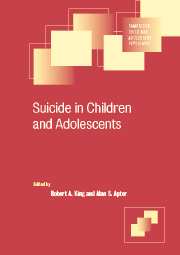Book contents
- Frontmatter
- Contents
- List of contributors
- Preface
- 1 The epidemiology of youth suicide
- 2 Suicide and the “continuum of adolescent self-destructiveness”: is there a connection?
- 3 Adolescent attempted suicide
- 4 Familial factors in adolescent suicidal behavior
- 5 Biological factors influencing suicidal behavior in adolescents
- 6 Psychodynamic approaches to youth suicide
- 7 Cross-cultural variation in child and adolescent suicide
- 8 An idiographic approach to understanding suicide in the young
- 9 Assessing suicidal behavior in children and adolescents
- 10 Suicide prevention for adolescents
- 11 Cognitive behavioral therapy after deliberate self-harm in adolescence
- 12 Follow-up studies of child and adolescent suicide attempters
- 13 Children and adolescents bereaved by a suicidal death: implications for psychosocial outcomes and interventions
- Index
- References
9 - Assessing suicidal behavior in children and adolescents
Published online by Cambridge University Press: 04 December 2009
- Frontmatter
- Contents
- List of contributors
- Preface
- 1 The epidemiology of youth suicide
- 2 Suicide and the “continuum of adolescent self-destructiveness”: is there a connection?
- 3 Adolescent attempted suicide
- 4 Familial factors in adolescent suicidal behavior
- 5 Biological factors influencing suicidal behavior in adolescents
- 6 Psychodynamic approaches to youth suicide
- 7 Cross-cultural variation in child and adolescent suicide
- 8 An idiographic approach to understanding suicide in the young
- 9 Assessing suicidal behavior in children and adolescents
- 10 Suicide prevention for adolescents
- 11 Cognitive behavioral therapy after deliberate self-harm in adolescence
- 12 Follow-up studies of child and adolescent suicide attempters
- 13 Children and adolescents bereaved by a suicidal death: implications for psychosocial outcomes and interventions
- Index
- References
Summary
The assessment of suicidal behavior in children and adolescents presents several unique clinical issues, specifically related to developmental factors that make such assessment a dynamic task of arriving at a clinical judgment of how likely it is that a child or adolescent will behave in a suicidal manner. Extensive research of the epidemiology, clinical characteristics, and longitudinal course of suicidal behavior suggests that suicidal behavior occurs throughout the human life span with similarities that make it a clinical necessity to evaluate all individuals who come for medical or psychiatric attention for their level of suicidal risk. The importance of evaluating children and adolescents for suicidal behavior is supported by recent U.S. national epidemiological statistics indicating that in the last two decades the rates of suicide among children and young adolescents, age 5–14 years, have doubled and the rates of suicide among adolescents and young adults, age 15–24 years, are among the highest rates of all ages and they continue to increase (Singh et al., 1996). This chapter will discuss a systematic approach based on an understanding of developmental issues that are important for evaluating children and adolescents for suicidal behavior. It will focus also on evaluating the major issues that are associated with risk for such behavior (American Academy of Child and Adolescent Psychiatry, 2001; see also Pfeffer, 2001).
The concept of suicidal behavior
Conceptualization of what constitutes suicidal behavior among children and adolescents is best considered within a schema of developmental psychopathology.
- Type
- Chapter
- Information
- Suicide in Children and Adolescents , pp. 211 - 226Publisher: Cambridge University PressPrint publication year: 2003
References
- 7
- Cited by

